If you've ever come across the lovable, tricolored Bernese Mountain Dog or admired the Great Pyrenees with their extra-large stature and signature white fur, you may already be familiar with types of mountain dog breeds.
While these unique breeds usually work on farms to protect herds of cattle, sheep, and other animals, they can also make great family dogs for the right people.
Here’s a list of some of the most beloved mountain dog breeds.
What is a Mountain Dog?
Mountain dogs are breeds that either originated in or work in mountainous regions. Most mountain dogs were bred to be livestock guardian dogs, and others may work as search and rescue dogs in the frigid, snowy mountains.
Mountain Dog Breed Characteristics
Most mountain dogs are large, powerful, and protective. They are considered expert-level breeds best left in the hands of experienced dog parents who know how to train and handle guardian breeds. Some breeds are so stocky and powerful that they historically pulled carts loaded with goods to sell at the market.
- 01 of 14
Bernese Mountain Dog

Getty Images
The Bernese mountain dog is one of four related Swiss mountain dog breeds developed to work on farms, herd livestock, and pull heavy carts. The other three are the Appenzeller Sennenhund, the Entlebucher mountain dog, and the greater Swiss mountain dog. All four breeds are similarly tricolored (black and white with tan markings), but their coat type and size vary.
The Bernese mountain dog is the only one of the four related Swiss mountain dog breeds to have a long coat, and it is the largest. These dogs originated near Berne, where they were a general-purpose farm dog used as a watchdog, property guard, and carting dog.
Intelligent and devoted to family, the Bernese mountain dog gets along well with children and most other pets. Although Berners are naturally protective, they are rarely aggressive. This breed needs moderate daily exercise, and you will need to brush out the thick coat at least weekly to keep shedding under control.
Breed Overview
Group: Working (AKC)
Height: 23 to 27.5 inches
Weight: 70 to 115 pounds
Personality/Temperament: Gentle, loyal, eager to please
Energy Level: Medium
Coat and Color: Thick, moderately long, slightly wavy or straight; tricolored (jet black with white and tan markings)
Life Span: 6 to 8 years
02 of 14Appenzeller Sennenhund
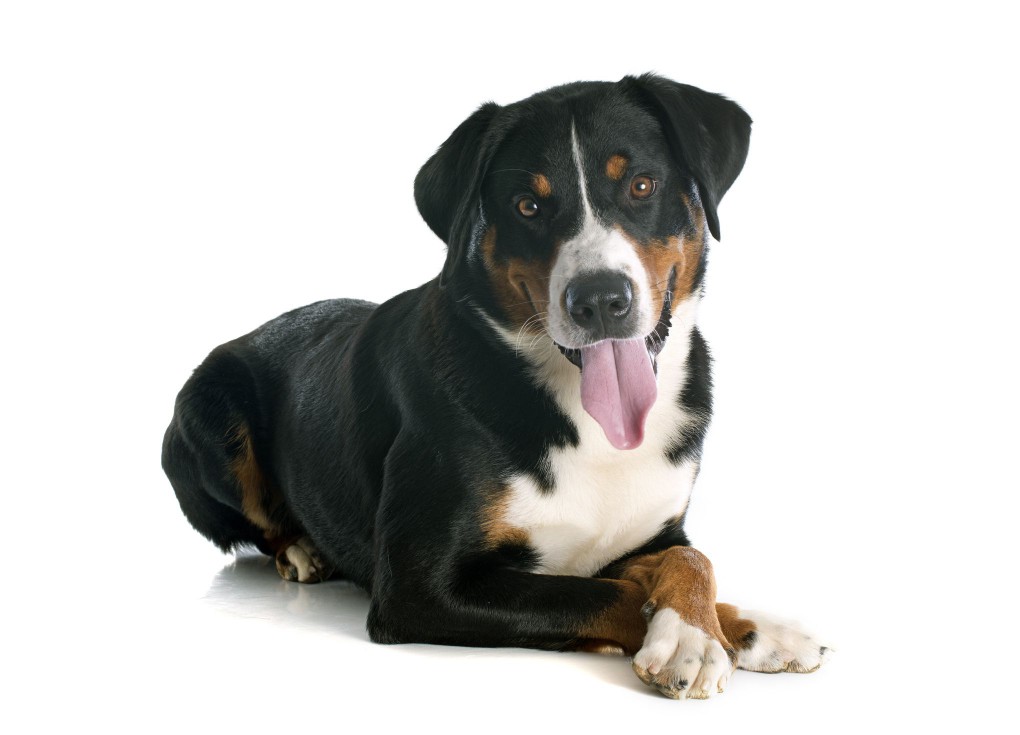
Getty Images
The Appenzeller Sennenhund is one of the four related Swiss mountain dog breeds. They are also called the Appenzeller mountain dog or Appenzell cattle dog, and this breed was primarily used to herd cattle and guard the farm.
They have high exercise and training needs, are apprehensive of strangers, and are best left to expert-level dog parents. They’re also unsuitable for families with young children.
Breed Overview
Group: Foundation Stock Service (AKC); not grouped
Height: 20 to 22 inches
Weight: 50 to 75 pounds
Personality/Temperament: Intelligent, lively, loyal
Energy Level: High
Coat and Color: Short, straight double coat; tricolor combination of black or brown with white and tan markings
Life Span: 12 to 14 years
03 of 14Caucasian Shepherd Dog
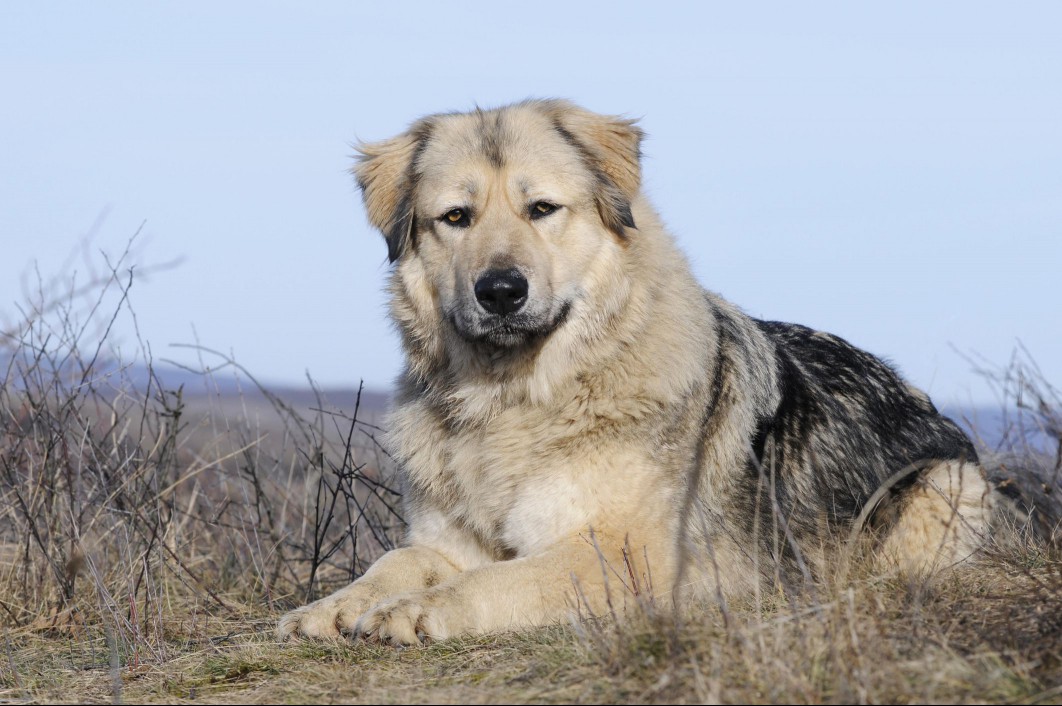
Getty Images
The Caucasian shepherd dog originated in the Caucasus mountain range, an expansive region between Europe and Asia. The breed guarded livestock and protected the homestead. This dog takes a bold, fearless, self-confident, and fierce stance when defending a flock.
Despite their protective nature, they're a teddy bear with family and other family pets. They can be challenging to train. Caucasian sheepdogs are a powerful breed best left to expert-level dog parents who have experience with large guarding breeds.
Breed Overview
Group: Foundation Stock Service (AKC); not grouped
Height: 23 to 30 inches
Weight: 99 to 170 pounds
Personality/Temperament: Protective, loyal, courageous
Energy Level: Medium
Coat and Color: Double coat ranges from short to heavy; solid, brindle, or spotted colors
Life Span: 10 to 12 years
04 of 14Entlebucher Mountain Dog
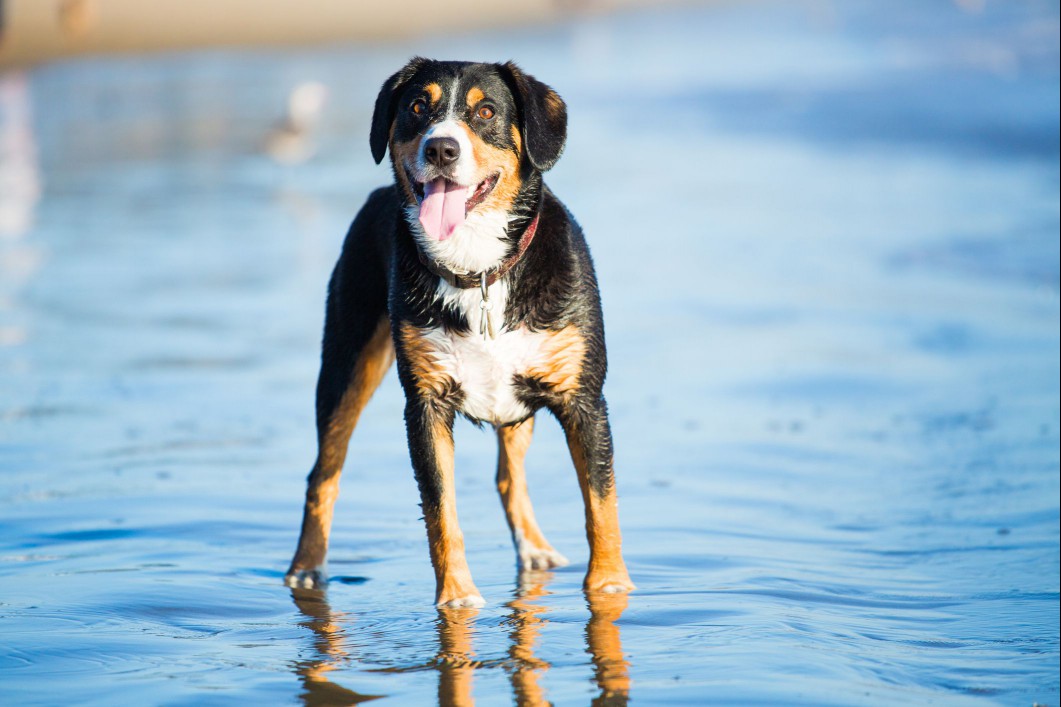
Getty Images
The Entlebucher mountain dog, also called the Entlebucher Sennehund or cattle dog, is the smallest and fastest of the four related Swiss mountain dog breeds. This dog needed speed for their primary job as a cattle drover. The breed was also used as an all-purpose farm dog and property guard in the Entlebuch valley, where it originated.
Entlebuchers are intelligent and independent but also utterly devoted to their human families. They love to play and generally get along well with gentle children. Though on the smaller side, Entlebuchers need a great deal of exercise to be content. Training is challenging for these strong-willed dogs.
Breed Overview
Group: Foundation Stock Service (AKC); not grouped
Height: 16 to 21 inches
Weight: 40 to 65 pounds
Personality/Temperament: Confident, loyal, companionable
Energy Level: High
Coat and Color: Short, dense, coarse coat; tricolored (jet black with white and tan markings)
Life Span: 11 to 15 years
Continue to 5 of 14 below05 of 14Great Pyrenees
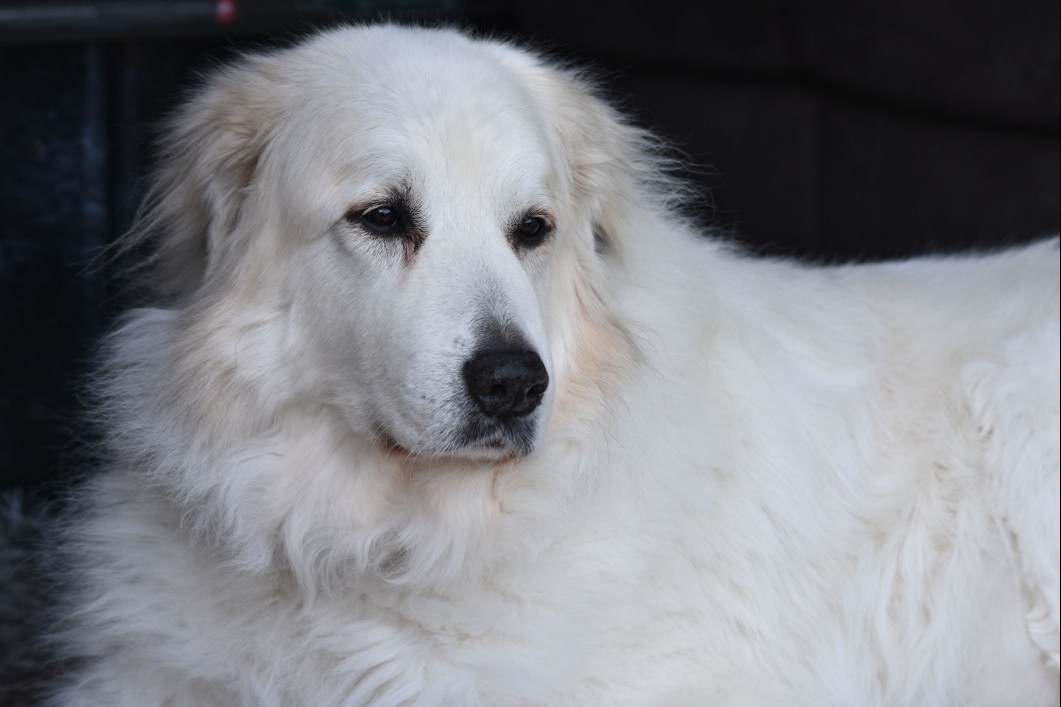
Getty Images
With their great size and white coat, the Great Pyrenees is magnificent to behold. The breed gets its name from the Pyrenees mountain range between Spain and France. These dogs worked high on the slopes of the mountains, guarding over flocks of sheep and protecting them from bears and wolves.
The Great Pyrenees is deeply devoted to family and watchful over their home. Though large, they are calm in the house and need only moderate daily exercise to be happy. They benefit from early training and socialization, as doing so can ensure they’ll behave well around strangers and other dogs.
Breed Overview
Group: Working (AKC)
Height: 25 to 32 inches
Weight: 100 to 150 pounds (males); 85 to 110 pounds (females)
Personality/Temperament: Affectionate, loyal, gentle
Energy Level: Medium
Coat and Color: Thick double coat; white, though may have markings of gray, tan, badger, or reddish-brown
Life Span: 10 to 12 years
06 of 14Greater Swiss Mountain Dog
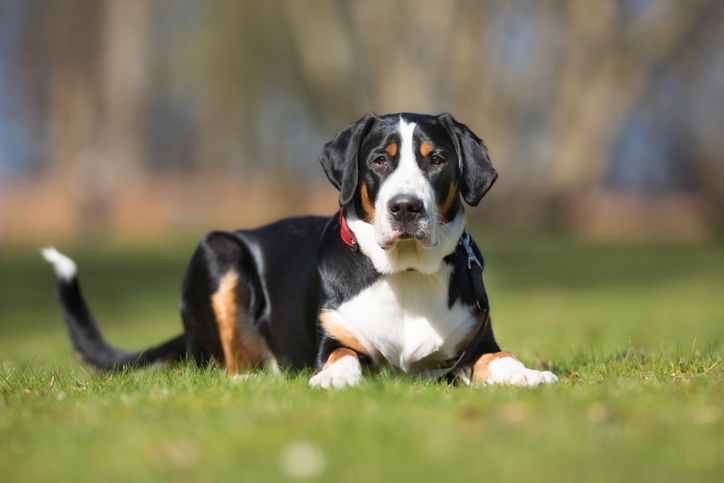
Getty Images
The Greater Swiss mountain dog is the oldest of the four Swiss mountain dog breeds. The Swissy was a hardworking farm dog that did it all: herding livestock, working in the pastures, guarding property, and pulling heavy carts to the market.
They are excellent watchdogs that sound the alarm in the presence of suspicious strangers near the home. Swissys are highly devoted to their family. But they need extensive socialization as puppies to avoid shyness in their adulthood.
These dogs only need moderate daily exercise since high-intensity exercise can stress their joints. Recommended activities include 30-minute walks or pulling carts, which many enjoy.
Breed Overview
Group: Working (AKC)
Height: 23 to 29 inches
Weight: 85 to 140 pounds
Personality/Temperament: Affectionate, friendly, loyal
Energy Level: Medium
Coat and Color: Short double coat; tricolored (jet black, white, and tan markings)
Life Span: 8 to 11 years
07 of 14Kuvasz
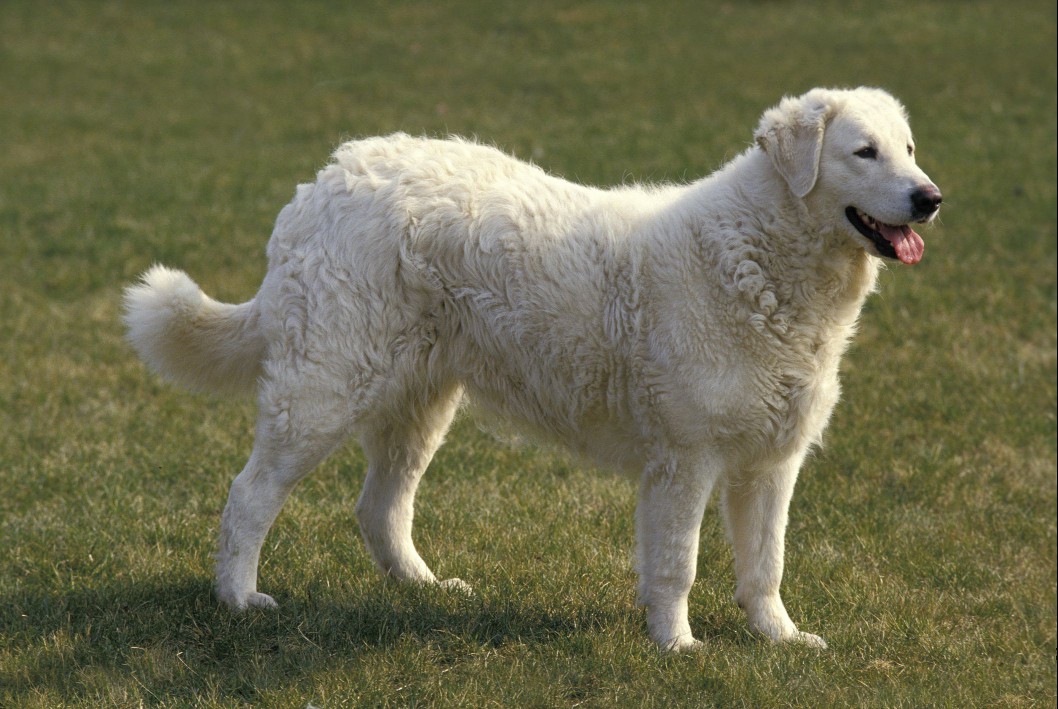
Getty Images
The Kuvasz is a large, all-white livestock guardian used in Hungary since the Middle Ages to protect horses, sheep, and cattle from predators and thieves. This breed hails from Hungary but likely originated in the steppes of Siberia’s Ural Mountains.
They generally get along well with respectful children. They are loyal, devoted, and protective of their families. The Kuvasz need early socialization as puppies, lifelong training, and extensive daily exercise. The breed is usually not recommended for novice dog parents.
Breed Overview
Group: Working (AKC)
Height: 26 to 30 inches
Weight: 70 to 115 pounds
Personality/Temperament: Intelligent, calm, affectionate
Energy Level: Medium
Coat and Color: Thick double coat, usually medium in length, ranging from straight to wavy; all white
Life Span: 10 to 12 years
08 of 14Saint Bernard
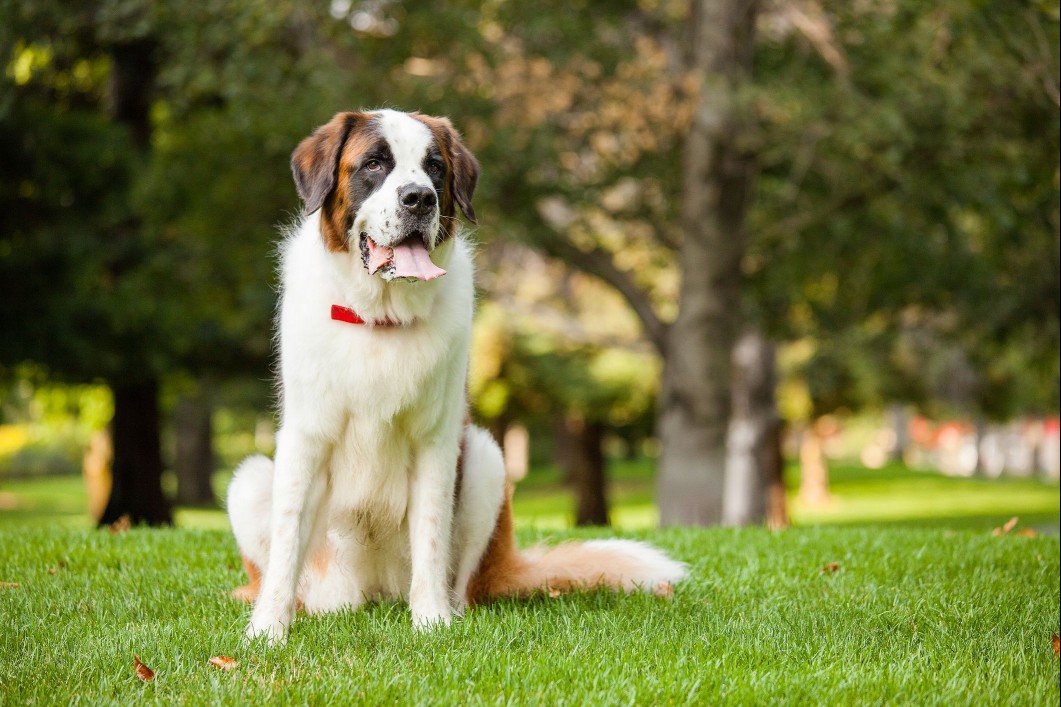
Getty Images
The majestic and steadfast Saint Bernard is famous for rescuing travelers in peril on the snowy slopes of the Swiss Alps. Monks developed the breed at the St. Bernard Monastery and Hospice, which Bernard de Menthon founded during the 11th century.
Today’s Saint Bernard is a gentle and faithful companion. They get along great with kids and love to be part of family activities. Saint Bernards are very large, calm, and laid-back. A few short walks a day is all they need for exercise, though many are up for more activity. Saint Bernards drool a lot, so if slobber grosses you out, this isn’t the best breed.
Breed Overview
Group: Working (AKC)
Height: 25.5 to 27.5 inches
Weight: 130 to 180 pounds
Personality/Temperament: Protective, affectionate, calm
Energy Level: Medium
Coat and Color: Short and smooth or long and silky; white with red, brown, or brindle markings
Life Span: 8 to 10 years
Continue to 9 of 14 below09 of 14Tibetan Mastiff
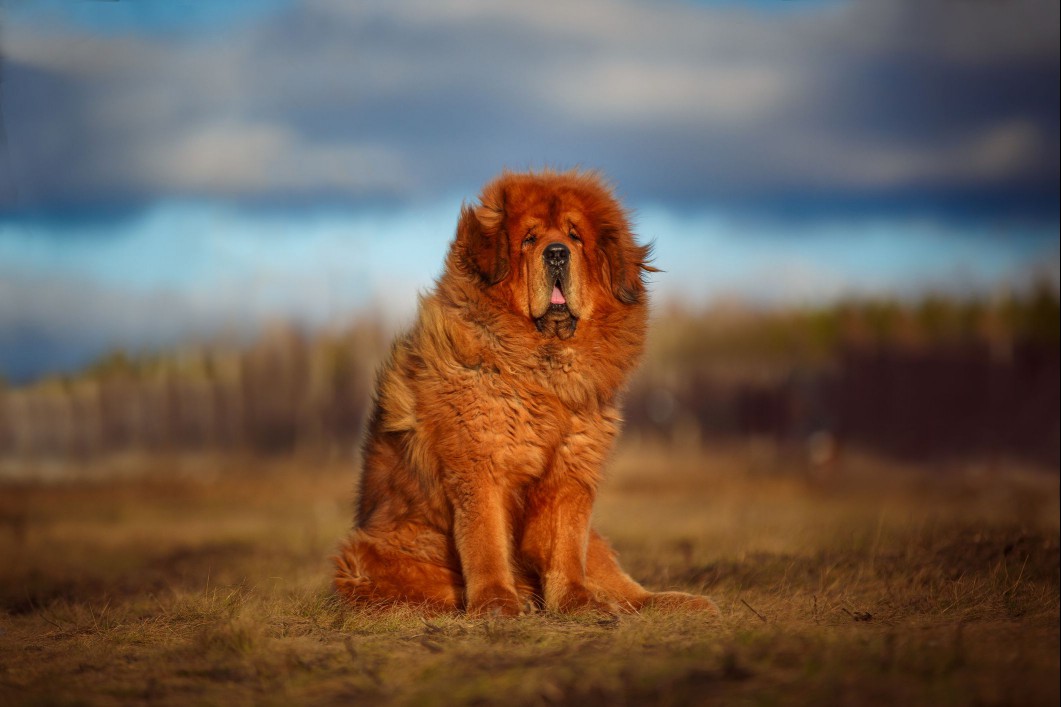
User7565abab_575 / Getty Images
The Tibetan mastiff is a primitive breed. This is a hardy dog that can survive in Tibet and the high-altitude Himalayan range. Shepherds used them to guard livestock, and, whether tending a flock or not, they remain more active at night than daytime.
This breed is not a fan of strangers and needs lots of space to roam. They can be excellent family dogs but require an experienced dog parent to keep them in check.
Breed Overview
Group: Working (AKC)
Height: 24 to 30 inches
Weight: 75 to 160 pounds
Personality/Temperament: Protective, intelligent, loyal
Energy Level: Low
Coat and Color: Long double coat; solid black, black and tan, various shades of red (from pale gold to deep red), and bluish-gray (dilute black); often with white and blue markings
Life Span: 12 to 15 years
10 of 14Newfoundland
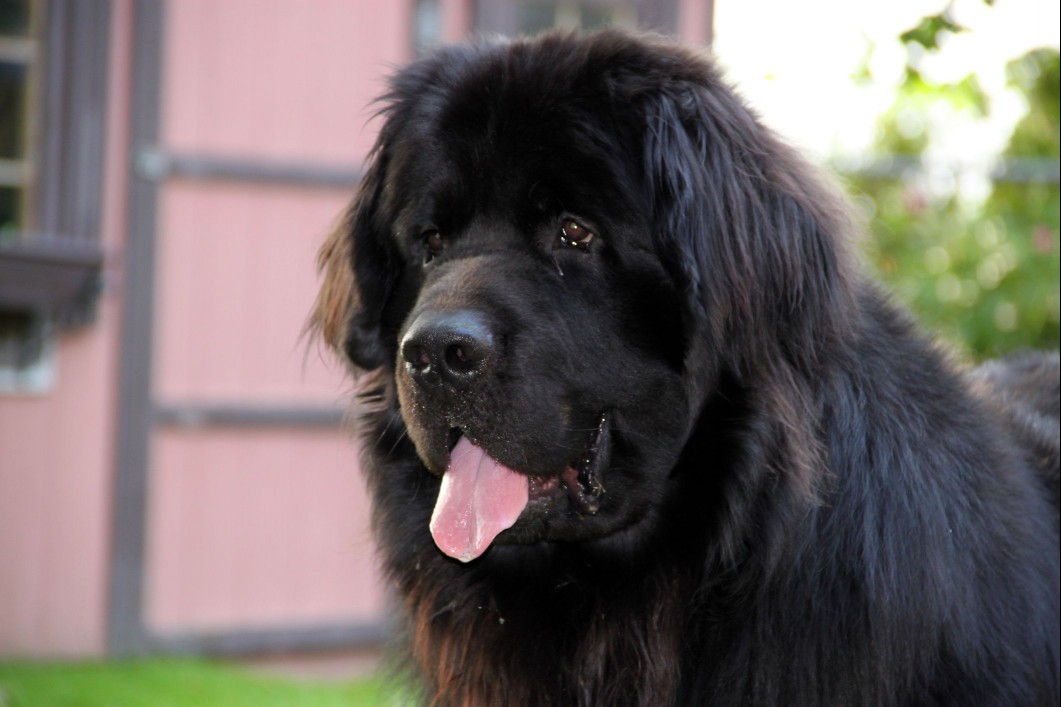
Getty Images
The native terrain of Newfoundland is hilly and rocky with plenty of perilous cliffs. The Newfoundland is a thick-coated canine that can withstand frigid, snowy winters and icy waters.
This breed did not originate in the mountain region but works as a search and rescue dog in water and mountain rescue missions worldwide. Newfoundlands are excellent working dogs as well as calm and affectionate companions.
Breed Overview
Group: Working (AKC)
Height: 26 to 28 inches
Weight: 100 to 150 pounds
Personality/Temperament: Calm, friendly, loyal
Energy Level: Medium
Coat and Color: Thick double coat; brown, black, gray, or black and white
Life Span: 8 to 10 years
11 of 14Leonberger
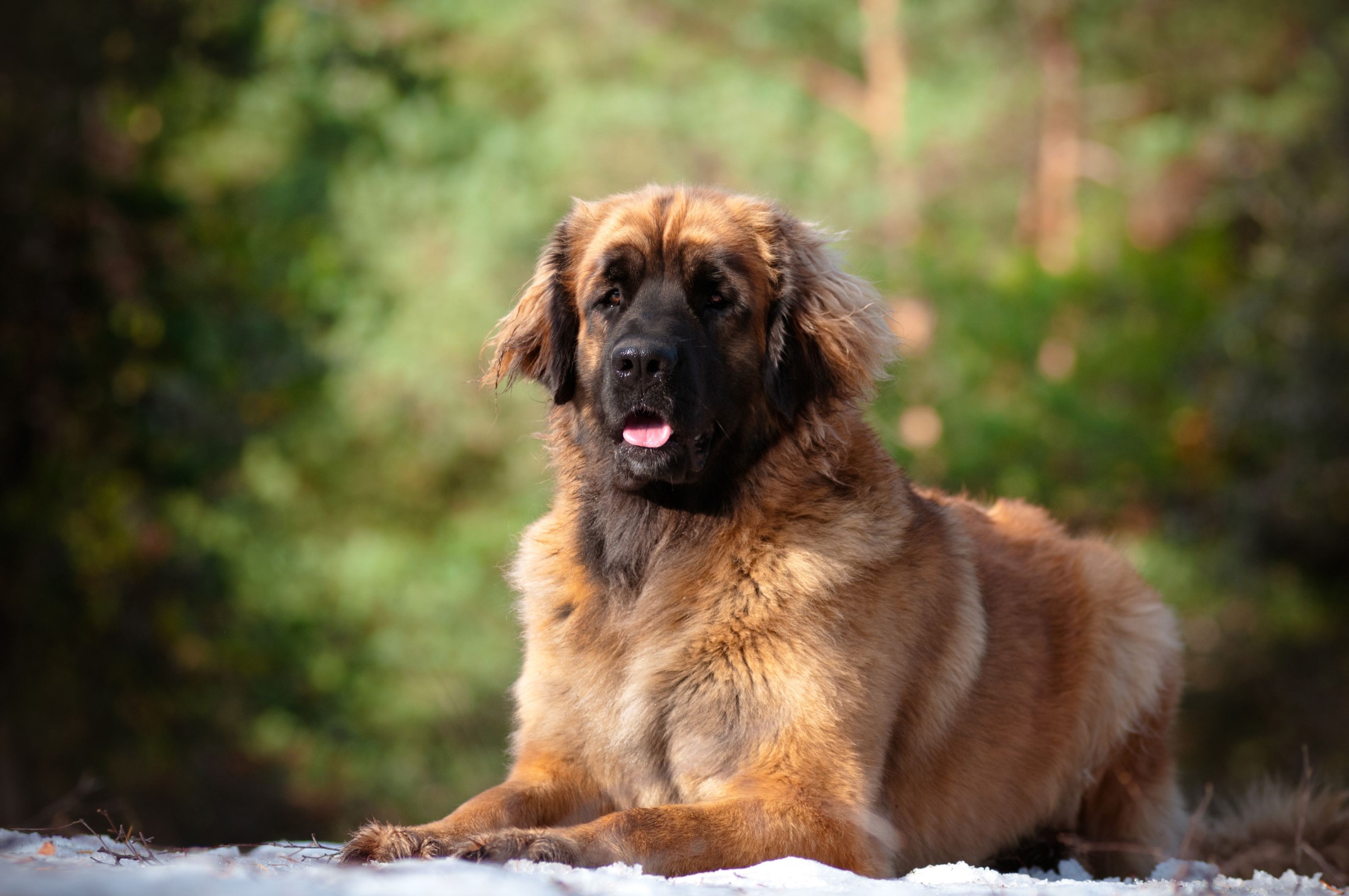
onetouchspark / Getty Images Also known as the Leo, the Leonberger is a giant dog breed from Germany, and it is a mix of the Newfoundland, the Great Pyrenees, and the Saint Bernard. The breed appeared in the U.S. and Canada in the early 1900s.
Leonbergers are loyal and intelligent, and they like being given a job to do. These dogs are gentle with their humans yet hard-working. They are also protective, so they can make good watchdogs. However, because of their size, they need a lot of space, and because of their energy, they need a lot of exercise.
Breed Overview
Group: Working (AKC)
Height: 25.5 to 31.5 inches
Weight: 90 to 170 pounds
Personality/Temperament: Affectionate, loyal, calm
Energy Level: Medium
Coat and Color: Double coat; medium to long; thick, straight; colors include lion-yellow, golden, red, reddish-brown, yellow-brown, and sandy; black mask on face
Life Span: 7 years
12 of 14Anatolian Shepherd
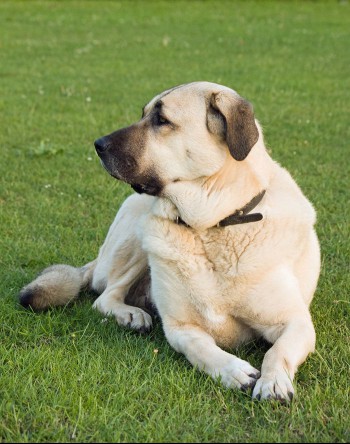
Karen Arnold/Wikimedia The Anatolian shepherd is a dog from Turkey that was bred to guard livestock and protect flocks of various animals, including goats, cattle, and sheep. These large dogs would bark loudly and work hard at keeping predators away. And they were capable of working on their own, thanks to their protective instincts and independent nature.
Because of their independent and protective side, these dogs do best when they are socialized early during puppyhood. They make good family dogs, but because of their size, they need plenty of space. And, even though they're very loyal, they aren’t overly affectionate dogs.
Breed Overview
Group: Working (AKC)
Height: 27 to 29 inches
Weight: 80 to 150 pounds
Personality/Temperament: Independent, protective, loyal
Energy Level: Medium
Coat and Color: Short, smooth; blue fawn, brindle, fawn, liver, red fawn, white, biscuit and white, or gray fawn with various markings and masks
Life Span: 11 to 13 years
Continue to 13 of 14 below13 of 14Icelandic Sheepdog
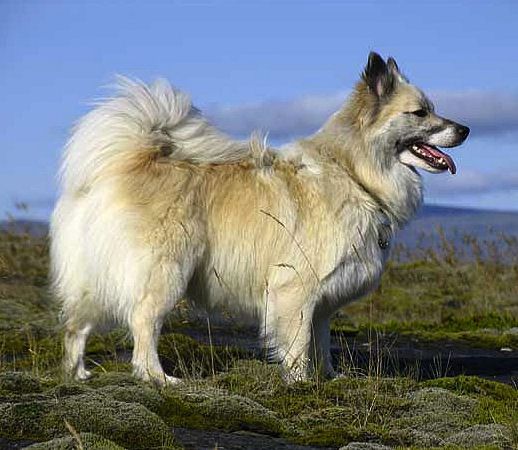
Photo © Runar T on flickr The rare Icelandic sheepdog is one of the oldest dog breeds in the world, and also Iceland’s only native breed. This is a spitz-type dog that is athletic, energetic, and hardy. They were bred to live in the mountainous areas of Iceland, where they herded livestock.
Icelandic sheepdogs make great pets because they are playful, affectionate, intelligent, and devoted. They are also good for families with kids and other pets. They have a lot of energy, so they need a couple hours a day of physical and mental exercise.
Breed Overview
Group: Herding (AKC)
Height: 18 inches (males); 16.5 inches (females)
Weight: 30 pounds (males); 25 pounds (females)
Personality/Temperament: Friendly, affectionate, playful
Energy Level: High
Coat and Color: Medium-length double coat; black and white; cream and white; fawn and white; gold and white; gray and white; red and white; sable and white; tan and white; white, tan, and black; or chocolate and white with a variety of markings and sometimes a black mask
Life Span: 12 to 14 years
14 of 14Karakachan
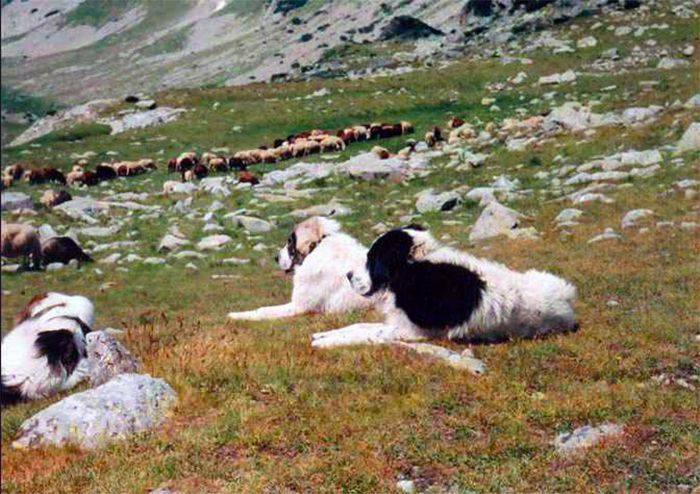
Karakachans guarding sheep in Bulgaria. The dogs are known for their bravery in fighting back against both wolves and bears. (Photo: Semperviva/Wikimedia) The Karakachan is an ancient dog breed from Bulgaria that was used to guard livestock. They were once used by the country’s military to help patrol their border, too. Today, they are used for guarding.
These dogs are affections to their family, but they are very protective and can be wary of strangers, so proper socialization and training from a young age is important. They also do best when they are given a job to do, so they are best for families who are active and can give them the daily activity that they need.
Breed Overview
Height: 24 to 30 inches
Weight: 66 to 120 pounds
Personality/Temperament: Affectionate, protective, loyal
Energy Level: High
Coat and Color: Dense, straight; long or short; white with black markings, sable, brindle, pied
Life Span: 12 to 14 years
Breeds to Avoid
If you are traveling in the mountains or hiking in rough, snowy terrain, you will need a dog that has endurance, longer legs for climbing and navigating uneven ground, and a warm, insulated coat.
The best bet is to steer clear of most toy breeds, like Maltese, Yorkies, and Pekingese, and most short-coated breeds, like greyhounds and whippets. They tend to lose body heat faster than larger or longer-haired dogs.
RECOMMENDED NEWS

Why Does My Dog Get Zoomies?
Has your dog ever started running around like a maniac for no apparent reason? Some dogs ...

Can Dogs Eat Brussels Sprouts? Safety, Benefits, and Prep Tips
Can dogs eat Brussels sprouts? Yes, when fed in moderation and properly prepared, Brussel...

Ant Bites on Dogs and How to Treat Them
Ant bites on dogs may be considered a minor nuisance, but when dogs stick their curious n...

Are Christmas Trees Poisonous to Cats and Dogs?
During the holiday season, you’re likely overwhelmed by your to-do list—picking the p...

Heat Exhaustion in Dogs
Heat exhaustion is a term used for moderate overheating, and it is very important to be a...

Bearded Collie: Dog Breed Characteristics & Care
The bearded collie is a medium-sized herding breed from Scotland with a sturdy body, flop...

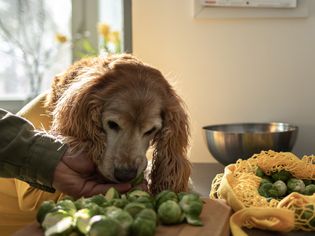
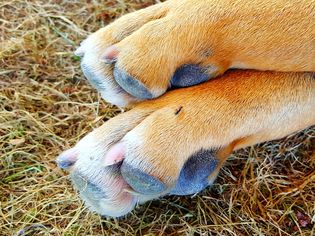
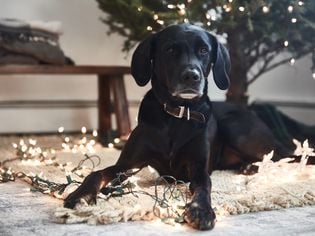
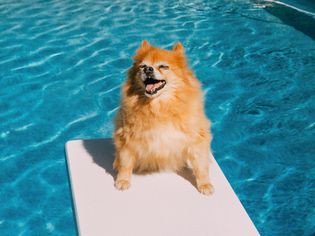

Comments on "14 Mountain Dog Breeds That Can Endure Tough Terrain" :